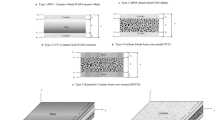Abstract
A sandwich beam model consisting of two face sheets and a foam core bonded by a viscoelastic adhesive layer is considered in order to investigate interfacial fracture behavior. Firstly, a cohesive zone model in conjunction with a Maxwell element in parallel, or with a Kelvin element in series, respectively, is employed to describe the characteristics of viscoelasticity for the adhesive layer. The models can be implemented into the implicit finite element code. Next, the parametric study shows that the influences of loading rates on the cohesive zone energy and strength are quite different for different models. Finally, a sandwich double cantilever beam model is adopted to simulate the interface crack growth between the face sheet and core. Numerical examples are presented for various loading rates to demonstrate the efficacy of the rate-dependent cohesive models.
Similar content being viewed by others
References
Kim J K, Yu T X. Forming and failure behaviour of coated, laminated and sandwiched sheet metals: a review. J Mater Process Technol, 1997, 63: 33–42
Vadakke V, Carlsson L A. Experimental investigation of compression failure of sandwich specimens with face/core debond. Compos Part B, 2004, 35: 583–590
Avilés F, Carlsson L A. Analysis of the sandwich DCB specimen for debond characterization. Eng Fract Mech, 2008, 75: 153–168
Siriruk A, Penumadu D, Weitsman Y J. Effect of sea environment on interfacial delamination behavior of polymeric sandwich structures. Compos Sci Technol, 2009, 69: 821–828
Dugdale D S. Yielding of steel sheets containing slits. J Mech Phys Solids, 1960, 8: 100–104
Barenblatt G I. The mathematical theory of equilibrium cracks in brittle fracture. Adv Appl Mech, 1962, 7: 55–129
Elices M, Guinea G V, Gómez J, et al. The cohesive zone model: advantages, limitations and challenges. Eng Fract Mech, 2002, 69: 137–163
Elmarakbi A M, Hu N, Fukunaga H. Finite element simulation of delamination growth in composite materials using LS-DYNA. Compos Sci Technol, 2009, 69: 2383–2391
Sridharan S, Li Y. Static and dynamic delamination of foam core sandwich members. AIAA J, 2006, 44: 2937–2948
Han T S, Ural A, Chen C S, et al. Delamination buckling and propagation analysis of honeycomb panels using a cohesive element approach. Int J Fract, 2002, 115: 101–123
Bažant Z P, Li Y N. Cohesive crack with rate-dependent opening and viscoelasticity: I. Mathematical model and scaling. Int J Fract, 1997, 86: 247–265
Allen D H, Searcy C R. A micromechanical model for a viscoelastic cohesive zone. Int J Fract, 2001, 107: 159–176
Wu Y Q, Huang F L. A micromechanical model for predicting combined damage of particles and interface debonding in PBX explosives. Mech Mater, 2009, 41: 27–47
Xu C, Siegmund T, Ramani K. Rate-dependent crack growth in adhesives: I. Modeling approach. Int J Adhes Adhes, 2003, 23: 9–13
Xu C, Siegmund T, Ramani K. Rate-dependent crack growth in adhesives II. Experiments and analysis. Int J Adhes Adhes, 2003, 23: 15–22
Zhu Y, Liechti K M, Ravi-Chandar K. Direct extraction of rate-dependent traction-separation laws for polyurea/steel interfaces. Int J Solids Struct, 2009, 46: 31–51
Cornec A, Scheider I, Schwalbe K. On the practical application of the cohesive model. Eng Fract Mech, 2003, 70: 1963–1987
Sun S Y, Chen H R. Quasi-static and dynamic fracture behavior of composite sandwich beams with a viscoelastic interface crack. Compos Sci Technol, 2010, 70: 1011–1016
Mi Y, Crisfield M A, Davies G A O, et al. Progressive Delamination Using Interface Elements. J Compos Mater, 1998, 32: 1246–1272
Ortiz M, Pandolfi A. Finite-deformation irreversible cohesive elements for three-dimensional crack-propagation analysis. Int J Numer Meth Eng, 1999, 44: 1267–1282
Xu X P, Needleman A. Numerical simulations of fast crack growth in brittle solids. J Mech Phys Solids, 1994, 42: 1397–1434
Makhecha D P. Dynamic Fracture of Adhesively Bonded Composite Structures Using Cohesive Zone Models. Dissertation for the Doctoral Degree. Virginia: Virginia Polytechnic Institute and State University, 2005
Li X M, Carlsson L A. Elastic foundation analysis of tilted sandwich debond (TSD) specimen. J Sandwich Struct Mater, 2000, 2: 3–32
Hibitt, Karlsson & Sorenson, Inc. ABAQUS User’s Manual Version 6.4, 2004
Wang J, Kang Y L, Qin Q H, et al. Identification of time-dependent interfacial mechanical properties of adhesive by hybrid/inverse method. Comp Mater Sci, 2008, 43: 1160–1164
Papanicolaou G C, Bakos D. Interlaminar fracture behaviour of sandwich structures. Compos Part A, 1996, 27: 165–173
Author information
Authors and Affiliations
Corresponding author
Additional information
Recommended by WANG JianXiang (Editorial Board Member)
Rights and permissions
About this article
Cite this article
Sun, S., Chen, H. The interfacial fracture behavior of foam core composite sandwich structures by a viscoelastic cohesive model. Sci. China Phys. Mech. Astron. 54, 1481–1487 (2011). https://doi.org/10.1007/s11433-011-4393-y
Received:
Accepted:
Published:
Issue Date:
DOI: https://doi.org/10.1007/s11433-011-4393-y




